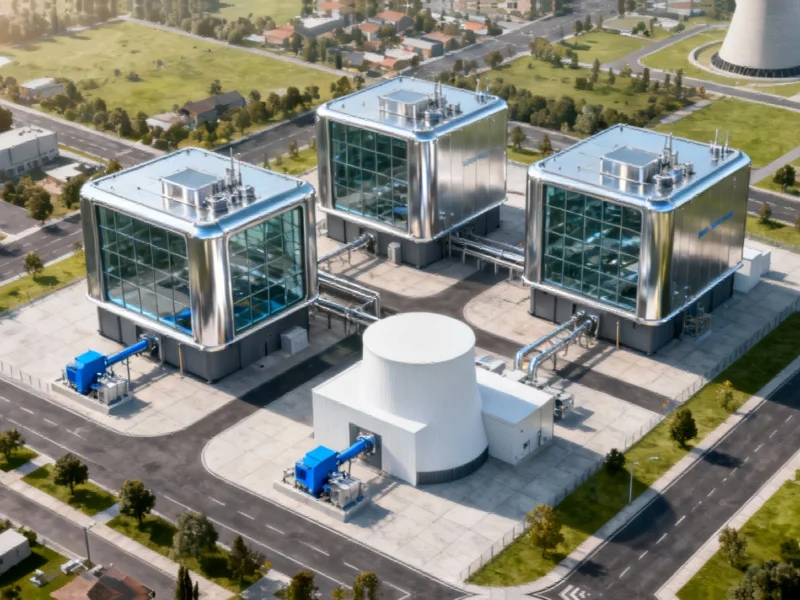According to TechSpot, Google has partnered with NextEra Energy to revive Iowa’s only nuclear power plant – the Duane Arnold Energy Center in Palo, near Cedar Rapids. The companies plan to reopen the 615-megawatt facility by the first quarter of 2029, pending regulatory approval, under a 25-year agreement where Google will purchase power for its cloud and AI infrastructure. The project will create more than 1,600 construction jobs and sustain approximately 400 permanent positions, generating over $127 million in annual earnings and $320 million in economic output for Linn County. This initiative represents a growing trend where tech companies are turning to nuclear power to meet surging AI energy demands, with Google noting that reopening existing facilities is one of the fastest ways to deploy large-scale clean energy.
Table of Contents
The Unavoidable Math of AI’s Power Hunger
What makes this announcement particularly significant is the underlying energy crisis that artificial intelligence has created for Big Tech. Training large language models like GPT-4 reportedly consumed enough electricity to power thousands of homes for a year, and inference – running these models for users – consumes exponentially more power over time. The computational intensity of AI workloads means that data centers that once consumed predictable amounts of electricity now face exponential growth curves. When you consider that a single ChatGPT query requires nearly ten times the computing power of a Google search, the scale of the problem becomes clear. Tech companies are realizing they cannot simply plug into existing grids without causing brownouts or skyrocketing energy costs for entire regions.
Why Nuclear Makes Strategic Sense for Tech
The choice of nuclear power represents a pragmatic calculation that goes beyond environmental credentials. Unlike solar and wind, nuclear provides baseload power – it runs 24/7 regardless of weather conditions, making it ideal for data centers that cannot tolerate interruptions. The decision to revive an existing plant rather than build new is particularly clever: regulatory approval processes are significantly shorter, existing transmission infrastructure can be reused, and local communities already familiar with nuclear operations are more likely to support the project. This approach allows Google to bypass the decade-long timelines and multi-billion dollar costs typically associated with new nuclear construction.
The Regulatory Minefield Ahead
Despite the apparent advantages, restarting a nuclear facility that has been idle for five years presents substantial regulatory and technical challenges. The Nuclear Regulatory Commission will require extensive safety reviews, equipment testing, and workforce certification before granting operational approval. Nuclear plants are complex systems where components degrade over time, even when not operating. The partnership between NextEra Energy and Google will need to demonstrate that all safety systems remain fully functional and that they’ve addressed any material aging that occurred during the shutdown period. This isn’t simply flipping a switch – it’s more like waking a sleeping giant and ensuring it’s still in fighting shape.
The Broader Tech Industry Shift
Google’s move follows similar initiatives across the industry, but with important distinctions. Microsoft has been exploring small modular reactors and recently hired a nuclear director to lead its atomic energy strategy. Amazon is investing in nuclear through its climate pledge fund. However, Google’s approach of directly partnering with an established operator like NextEra to revive existing infrastructure may prove more immediately practical than betting on unproven next-generation technologies. As Google’s infrastructure team noted, this represents a template that could be replicated across other shuttered nuclear sites nationwide, potentially bringing multiple gigawatts of carbon-free power back online within years rather than decades.
Beyond Energy: The Economic Calculus
The economic impact extends far beyond the direct job creation numbers. For states like Iowa, this represents an opportunity to transition from agricultural and manufacturing economies to becoming energy exporters to the digital economy. The $3 million in annual tax revenue mentioned in the announcement will directly support local schools and infrastructure, creating a virtuous cycle where tech investment funds community development. More strategically, reliable nuclear power makes these regions attractive for future data center investments, potentially creating technology hubs in areas previously overlooked for such development. As the companies emphasized, this partnership could serve as a model for similar collaborations nationwide.
What Comes Next in the Atomic Age of Computing
Looking forward, this announcement signals a fundamental restructuring of how tech companies approach energy security. We’re likely to see more vertical integration where companies directly invest in generation capacity rather than simply purchasing power from utilities. The exploration of additional nuclear projects that Google and NextEra are undertaking suggests this is the beginning of a broader strategy. The timing is particularly interesting given Google’s parallel investment in three new nuclear projects with Elementl Power – the company appears to be pursuing both near-term (reactivating existing plants) and long-term (new construction) nuclear strategies simultaneously. This diversified approach acknowledges that no single solution will meet the staggering energy demands of the AI era.



